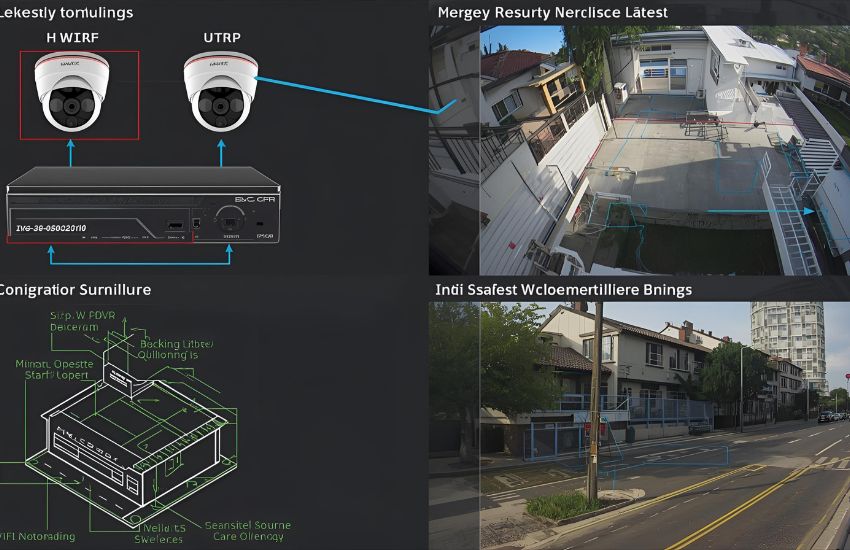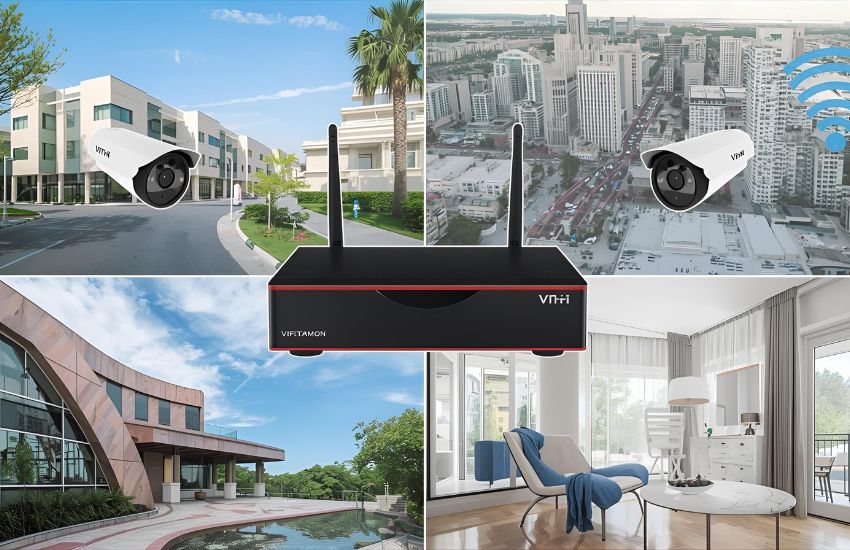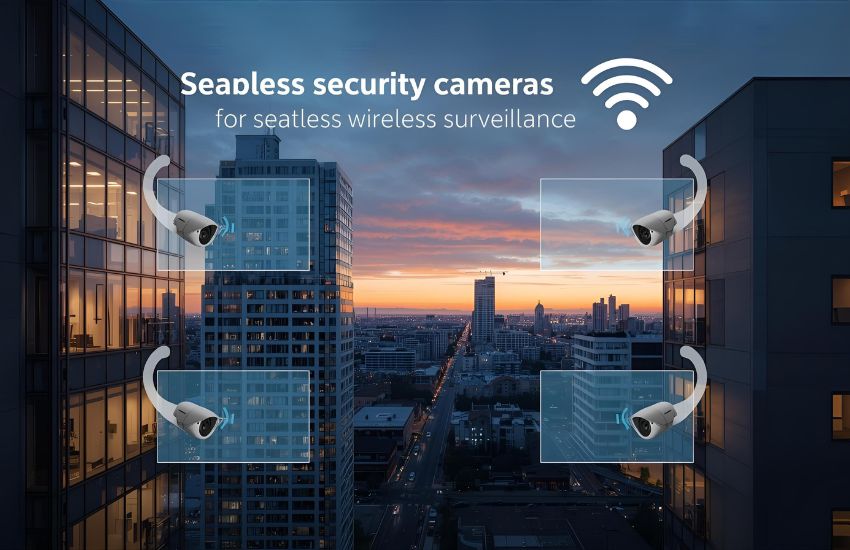Connecting security cameras across multiple buildings to a DVR via WiFi offers a powerful solution for seamless wireless surveillance. As you expand your camera system beyond a single structure, relying on cables can become impractical and costly. Wireless IP cameras eliminate this challenge by transmitting video signals over a WiFi network, enabling flexible installation without the constraints of Ethernet or PoE wiring.
To connect security cameras on multiple buildings to a DVR via WiFi, use high-quality wireless IP cameras and ensure each building has a strong WiFi network or point-to-point wireless bridges. Configure cameras to connect to the central DVR’s network, using routers or access points for seamless data transmission and reliable, wireless surveillance across all locations.
In this blog, you will learn step-by-step how to connect your CCTV cameras across separate buildings to a centralized DVR using WiFi, including key considerations for network setup, camera placement, and troubleshooting tips. By mastering these techniques, you can establish a reliable wireless surveillance system that meets your security needs while minimizing infrastructure complexity.
Understanding Wireless Camera System Options for Multi-Building Surveillance

When you need to connect security cameras across two buildings or multiple outbuildings, choosing the right wireless camera system is essential to maintain effective surveillance without the hassle of running cable. Understanding the available options will help you implement a reliable wireless security setup tailored to your property’s layout and needs.
Wireless Bridges and WiFi Bridges
A wireless bridge or WiFi bridge creates a direct line connection between two network points, allowing network IP cameras in one building to transmit video to the DVR or server located in another. This solution is particularly useful when you want to avoid running ethernet cable between buildings. For example, a point-to-point wireless system uses a transmitter and receiver to establish a direct line of sight connection, ensuring stable video transmission with minimal interference.
Access Points and Point-to-Multi-Point Systems
If you have multiple outbuildings or want to connect several cameras wirelessly, a point-to-multi-point wireless system with access points can distribute network signals across multiple locations. This allows you to connect cameras from various areas on a single network router or wifi router without needing separate per camera wiring.
Power and Connectivity Considerations
When setting up a wireless security system, camera power options such as PoE or local power supplies are important to consider. Additionally, while wireless eliminates the need to run cable for data transmission, you might still need to run cable to power certain cameras. Selecting the right combination of wireless technology and camera power ensures your security system performs reliably with features like motion detection and continuous recording on your DVRs.
By understanding these wireless camera system options, you can design a flexible, efficient surveillance network that meets your security requirements across multiple buildings.
How to Set Up a Reliable Wireless Camera System Using IP and CCTV Cameras

Establishing a dependable wireless camera system across multiple locations requires careful planning and the right equipment. Whether you use IP cameras like Hikvision models or traditional analog CCTV cameras, the goal remains the same: to achieve consistent video transmission with peace of mind.
Planning Your Network and Bridge Connection
Start by assessing your site’s layout. To connect your main building with building B or other outbuildings, you need an unobstructed direct line of sight—or line of site—between wireless devices. Devices like Nanostation or wireless bridges equipped with omnidirectional antennas can help maintain strong signals. Ensuring a stable bridge connection capable of handling sufficient Mbps will support many cameras streaming video without interruption.
Camera Installation and Power Setup
When mounting cameras, use a sturdy mounting bracket for proper alignment and security. For IP cameras, PoE ports simplify installation by combining power and data transmission through a single ethernet cable. Analog cameras may require adapters or separate power sources. Keep in mind that power adapters and cable runs should be planned to minimize downtime.
Configuration and Monitoring
Once cameras are added to the NVR or NAS, configure motion detection settings to receive real-time alerts on your mobile app or computer. This alert functionality enhances your security system’s responsiveness. Viewing live or recorded footage on a TV or computer offers convenient monitoring and quick access to related video when needed.
By following these steps, you can build a wireless camera system that effectively covers multiple locations, delivering reliable surveillance and peace of mind for your property.
Ensuring Seamless Surveillance with the Right Camera System and Network Design

To achieve seamless surveillance between your main building and a second building, you must carefully design both your camera system and network infrastructure. When transmitting data wirelessly, maintaining a clear line and full signal between points is critical to prevent video interruptions or lag. You should consider using high-quality equipment, such as an 8 channel DVR paired with cat5e cables where wired connections are possible, to support high resolution video streams without bottlenecks.
If running cables proves challenging, try using powerline adapters as an alternative method to extend your network through existing electrical wiring. This can help maintain stable connectivity without the need for additional wiring. Monitoring your network’s ping and signal strength will also help you identify and address latency or packet loss issues that could affect video quality.
Ultimately, your surveillance system’s reliability depends on the balance of well-chosen camera hardware and a thoughtfully designed network. Prioritizing a robust connection between buildings ensures that your security cameras provide consistent, clear footage—giving you peace of mind through uninterrupted monitoring.
Conclusion
In conclusion, setting up a reliable surveillance system across multiple buildings hinges on the right combination of a DVR, wireless network, and carefully planned infrastructure. Your security camera system’s effectiveness depends on how well your CCTV cameras can transmit high-quality video signals through a stable router and network, whether wired via ethernet or wirelessly. Utilizing components such as a POE switch can simplify power and data delivery, but a strong wireless network is equally vital to ensure seamless video surveillance. By integrating these elements thoughtfully, your surveillance system will provide continuous monitoring and peace of mind, with your DVR efficiently managing and recording footage for comprehensive security coverage.
Frequently Asked Questions (How to Connect Security Cameras on Multiple Buildings to DVR via WiFi for Seamless Wireless Surveillance)
Can I connect a WiFi camera to a DVR?
Yes, you can connect a WiFi camera to a DVR, but it requires compatibility and proper setup. Most traditional DVRs support only wired analog cameras, while NVRs are designed for IP and WiFi cameras. If your DVR supports IP camera integration or has hybrid functionality, you can add WiFi cameras through network configuration and software settings.
How to connect multiple WiFi cameras?
To connect multiple WiFi cameras, ensure each camera supports wireless connectivity and connect them individually to the same WiFi network through their apps or software. Assign unique names or IP addresses to avoid conflicts. Use a stable router with sufficient bandwidth and consider a Network Video Recorder (NVR) or cloud storage for centralized monitoring and recording.
Can I get access to a CCTV camera on multiple devices?
Yes, you can access a CCTV camera on multiple devices if it supports remote viewing. Most modern CCTV systems allow monitoring through mobile apps, PCs, or tablets by connecting via the internet. You simply need the camera’s app, login credentials, and a stable connection. This ensures real-time monitoring from different devices simultaneously.
How do CCTV operators typically monitor multiple cameras simultaneously?
CCTV operators monitor multiple cameras simultaneously using video management software (VMS) or digital video recorders (DVR/NVR) that display feeds on multi-screen setups. They often organize cameras by priority or location, use split-screen views, and rely on motion detection alerts. Operators continuously scan screens, focus on suspicious activity, and can zoom or switch views for detailed monitoring.
